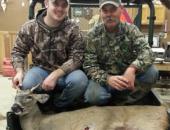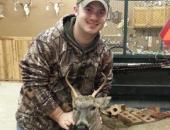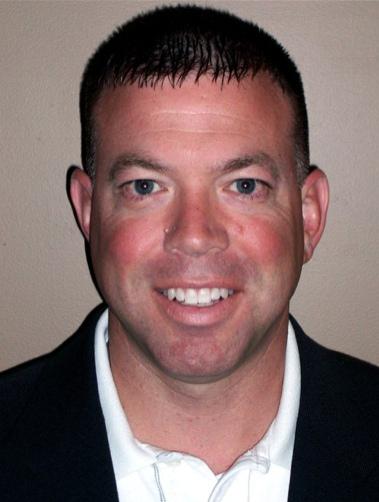
Bloomfield, Missouri – The Missouri State Veterans Cemetery in Bloomfield, Missouri will host its annual Veterans Day Program on Tuesday, November 11, 2014.
Keynote speaker for this year’s Veterans Day Program will be Lt. Col. Ed Gargas.
"Ed joined Bagby Wealth Management as a Sales Manager in 2014. He holds a Bachelor of Science in Business Administration from Southeast Missouri State University, as well as a Masters in Business Administration from William Woods University. In addition to his experiences in the banking and insurance industries, Ed has served as Project and Marketing Manager for KMC Construction/ServiceMaster and as Regional General Manager for NewWave Communications.
Ed is a commissioned officer in the Missouri National Guard and currently holds the rank of lieutenant colonel. He is a combat veteran of Operation Iraqi Freedom and has received four Army commendation medals and many other awards for his performance and service. Ed’s assignments in the military have included: battalion operations officer, battalion executive officer, division engineer, and company commander.
Ed is a member of the First Baptist Church in Dexter, as well as various other community and civic organizations including the Kiwanis Club, the Dexter Economic Development Board, the American Legion, and the Dexter Chamber of Commerce. He and his wife Tina have one son, Nate."
Please honor our veterans at 1:00 p.m. at the Committal Shelter Plaza in the Veterans Cemetery.
The general public is invited and encouraged to attend to honor those who served in our military.
For more information contact the cemetery at 573-568-3871.
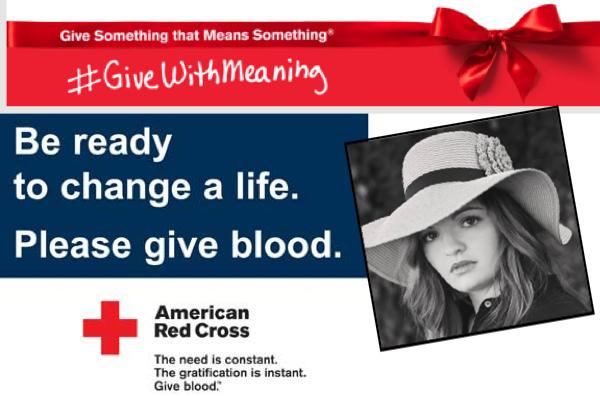
Whether you host a blood drive or give blood, you'll be giving a gift that can help save a life. When you do, you'll discover the true meaning of giving – and it won't cost a thing!
You can help encourage others to get in the giving spirit, too. Just share this video on social media along with #GiveWithMeaning.
The American Red Cross asks eligible donors to make an appointment to give blood to help ensure sufficient blood supplies are available for patients this holiday season.
Blood donations often decline during the holidays when donors get busy with travel and family gatherings, but the need for blood remains steady. Someone in the U.S. needs blood every two seconds.
Eligible donors with all types are needed, especially those with O negative, A negative and B negative. To learn more about donating blood and to schedule an appointment, download the Red Cross Blood Donor App, visit redcrossblood.org or call 1-800-RED CROSS (1-800-733-2767).
As extra encouragement to donate blood during the busiest time of November for many people, presenting blood donors from Nov. 26 through Nov. 30 will receive a limited-edition Red Cross potholder stuffed with unique celebrity chef recipes, while supplies last. Thanksgiving recipes are courtesy of Mario Batali, Rocco DiSpirito, Alex Guarnaschelli and Mike Isabella.
For more information visit redcrossblood.org or call us at 1-800-RED CROSS (1-800-733-2767).We appreciate your support, and look forward to seeing you this holiday season!
Upcoming blood donation opportunities:
Puxico - Hosted by Puxico High School
11/17/2014: 8:30 a.m. - 1:30 p.m.,
Puxico High School, 481 North Bedford
Dexter, Missouri - Hosted by the Dexter Rotary Club
11/25/2014: 12 p.m. - 5 p.m.,
Sacred Heart Catholic Church, 102 East Castor
How to donate blood
Simply download the American Red Cross Blood Donor App, visit redcrossblood.org or call 1-800-RED CROSS (1-800-733-2767) to make an appointment or for more information. All blood types are needed to ensure a reliable supply for patients. A blood donor card or driver’s license or two other forms of identification are required at check-in. Individuals who are 17 years of age (16 with parental consent in some states), weigh at least 110 pounds and are in generally good health may be eligible to donate blood. High school students and other donors 18 years of age and younger also have to meet certain height and weight requirements.
About the American Red Cross
The American Red Cross shelters, feeds and provides emotional support to victims of disasters; supplies about 40 percent of the nation’s blood; teaches skills that save lives; provides international humanitarian aid; and supports military members and their families. The Red Cross is a not-for-profit organization that depends on volunteers and the generosity of the American public to perform its mission. For more information, please visit redcross.org or visit us on Twitter at @RedCross.
Photo of Riley Jo Rickman by
Elaine Rohde Photography
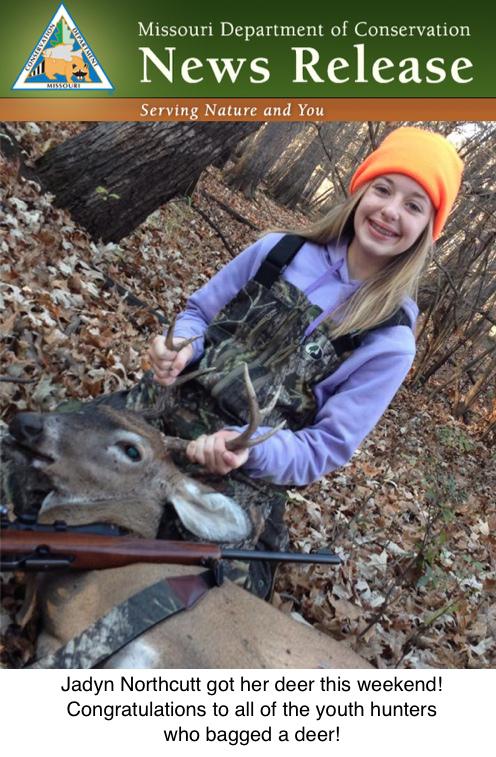
Antlered bucks accounted for 11,481 of deer harvested, or about 63 percent. Button bucks accounted for 1,728, or almost 10 percent. Does accounted for 4,882, or about 27 percent.
For harvest totals by county, visit the MDC website at mdc.mo.gov/node/29442.
Up next for deer hunting in Missouri is the November portion of firearms deer season running Nov. 15 through 25. This portion normally accounts for about 80 percent of the state’s firearms deer harvest.
Get more information on deer hunting in Missouri through MDC's free 2014 Fall Deer & Turkey Hunting Regulations and Information booklet available where permits are sold, from MDC regional offices and nature centers, and online at the MDC website at mdc.mo.gov/sites/default/files/resources/2010/03/ftd2014.pdf.
Shown in the photo is Jadyn Northcutt from Dexter, Missouri. She bagged her 6-point buck during the Missouri Youth Hunt. This is her first deer! Way to go Jadyn!!!

Stoddard County, Missouri - Route AD in Stoddard County will be reduced to one lane as the Missouri Department of Transportation crews perform bridge maintenance.
The bridge is located over US 60 west of Dexter.
Weather permitting, work will take place Monday, Nov 3 through Thursday, Nov. 6 from 7:30 a.m. to 4:30 p.m. daily.
The work zone will be marked with signs. Motorists are urged to use extreme caution while traveling near the area.
For additional information, contact MoDOT's Customer Service Center toll-free at 1-888-ASK-MODOT (1-888-275-6636) or visit www.modot.org/southeast.
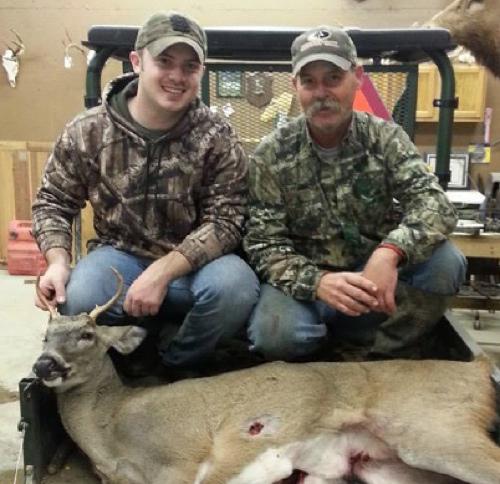
Conservation Department Resource Scientist Emily Flinn says this year’s mild summer will send deer into autumn in good physical condition. Hot, dry summers, like those of 2012 and 2013, cause physical stress on deer, increasing their nutritional needs while simultaneously reducing food supplies. Deer got a break from the weather this year, with cooler than average temperatures and plenty of food.
The Conservation Department tracks deer populations at the county level by analyzing the number and sex of deer checked during deer season and through surveys of hunters and landowners. It also factors in other influences, such as disease.
Deer populations in central, northern, and western Missouri have decreased steadily over the past decade partially as a result of regulations that allowed hunters to shoot more does.
“It’s important to remember that deer numbers were significantly above target levels in the early 2000s,” says Flinn. “The liberal regulations were intended to gain control of the deer population, and they did. Then the hemorrhagic disease outbreaks in 2012 and 2013 pushed populations even farther below desired levels in some areas. The Conservation Department reduced the number of firearm antlerless permits that hunters can fill in some counties this year to allow the population to increase back to desired levels.”
Flinn says the effects of previous hemorrhagic disease outbreaks will continue to be felt this year. That is particularly true in the northern half of the state. However, losses to blue tongue and epizootic hemorrhagic disease were not spread evenly across any region of the state.
“Localized deer populations that experienced moderate to high hemorrhagic mortality from the 2012 outbreak and last year in northeast Missouri have likely not recovered to levels prior to the outbreak,” says Flinn. “Due to the localized manner in which hemorrhagic disease operates, it is important that hunters and landowners continue to reduce doe harvest if deer numbers in their areas are below desired levels. On the other hand, if numbers in a localized area are at or above desired levels, then the continuing doe harvest is necessary to reduce or maintain populations.”
In contrast, she says, several years of conservative harvest regulations in southern Missouri have allowed deer populations to slowly increase. However, deer population levels are still largely below desired levels in much of southern Missouri.
Deer population size affects deer harvest, but other factors are important, too. One of the most important factors is food availability.
In southern Missouri, acorns dominate deer diets in the fall and winter. When acorns are plentiful, deer can find all the food they need without moving around much. This tends to spread deer across the forested landscape, making them difficult to find. Conversely, in years when acorns are scarce, deer move around more and tend to concentrate around available food sources, making them easier to find. Early reports indicate that Missouri will have an average crop of acorns from both white and red oaks this year, neither helping nor hindering hunters in the Ozarks.
“Scouting can help hunters figure out deer travel routes and where they might be visible,” says Flinn.
She also advised hunters to consider how agricultural activity on neighboring land might affect deer behavior.
Flinn emphasizes the important role hunters play in determining local deer population size and structure. Shooting one or two does on your property might not seem very significant, but in combination with deer harvest on adjacent land, it can add up.
“Most people think the Conservation Department manages deer, but in reality it is a collaborative effort between the Department and hunters and landowners,” says Flinn. “On private land, our management is on a large scale. We can regulate how many antlerless tags a hunter can fill in a particular county, but hunters and landowners ultimately make the decision about how many deer to harvest within constraints of regulations. So hunters and landowners have a great deal of influence on local deer numbers.”
Flinn says the patchy nature of losses to hemorrhagic diseases across the landscape makes hunter involvement in managing deer more important than ever. Hunters who see that deer numbers are down where they hunt should consider the future when deciding whether to harvest does.
The first step in managing local deer populations is coordinating your hunting activities with neighbors. Forming a deer cooperative can be as simple as sitting down over coffee to discuss what you want to achieve. Once you agree on goals for the local deer herd, the next step is tailoring your deer harvest to achieve those goals. More information on the status of Missouri’s deer population and regional trends in deer populations is available in the 2013-2014 Missouri Deer Season Summary and Population Status Report mdc.mo.gov/node/28399.
This year’s deer-hunting regulations include changes to availability of firearms antlerless permits in some counties. Details about this and other regulations, including season dates, are available in the 2014 Fall Deer & Turkey Hunting Regulation and Information booklet. It is available wherever hunting permits are sold or at mdc.mo.gov/node/3656.
